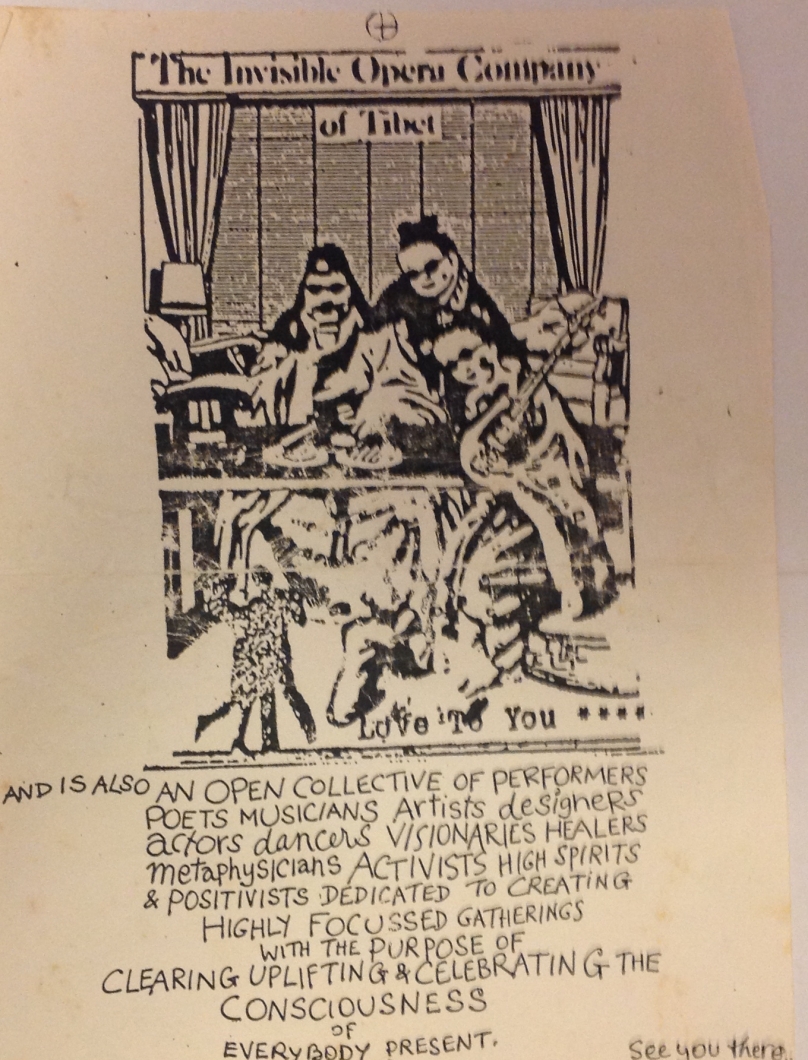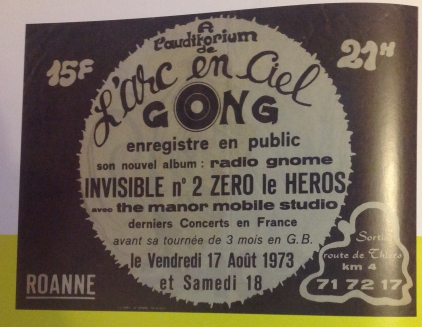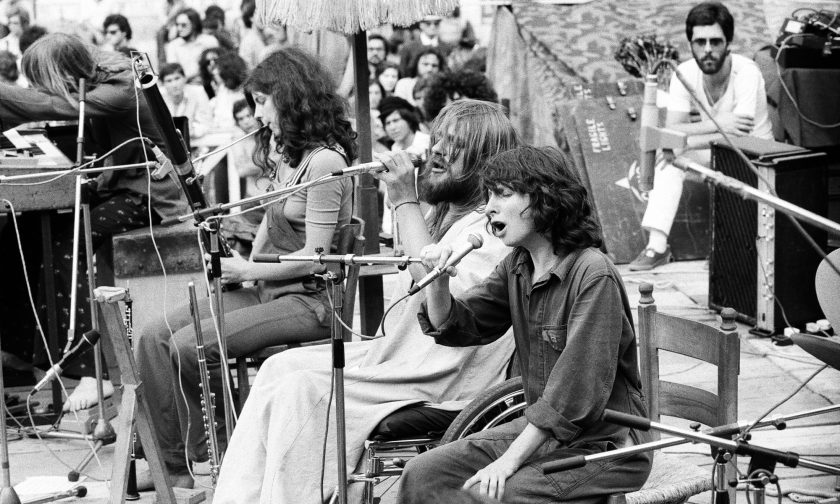
Steve Hillage
After a 3 gig taster in the summer, the Steve Hillage Band set out on a much larger tour in early November, this time with a twist – not only would the current Gong band be the musicians backing Steve and Miquette Giraudy for their extended 2 hour sets each evening, but Gong themselves would be the support act each night. Interestingly enough, this reverses the scenario from exactly a decade ago when Steve, who was then Gong’s guitarist, promoting the ‘2032’ album, did the support act to Daevid Allen’s Gong with a Steve Hillage Band consisting of himself, Miquette, Mike Howlett and then Gong drummer Chris Taylor.
I’m not sure I’ve ever seen a bad gig in Liverpool – I suppose part of that experience is that whilst I’ve dropped in on many gigs casually in Manchester over the years, every trek down the M62 has been for a special event of some sort. Plus audiences here seem determined to have something of a party. There’s certainly little standoffishness. The O2 Academy is somewhat more welcoming than its sister venue than the Ritz in Manchester– queues are more manageable, security almost human and the venue, upstairs on a sticky dance floor, somewhat less congested, to the extent that it was possible to navigate around to different spots in front of the stage without seriously cheesing off your fellow gig-goers.

Kavus Torabi
Gong sensed it too – relatively early in the set Kavus Torabi, already beaming from ear to ear, was encouraging the audience to levitate the dance hall and ‘lose their shit’. The band played for an hour but it felt like longer – it was certainly intense enough for one to have quite legitimately wandered away at the end of their set being satisfied with the evening’s events on Gong’s performance alone. The band played 5 tracks, the new opus ‘Forever Reoccuring’, imbued with transcendental atmospherics and a lovely new twist where vocals (whose lyrics I could not fully decipher) embellish the rising mid-piece section; a rather splendid version of ‘Rejoice!’ where Kavus pulled out an extraordinary guitar solo; ‘You Can’t Kill Me’ with an unexpected highlight when Dave Sturt’s bass sound packed in, memorable because of his bisonesque re-joining of the fold once order was restored (“I WAS quite angry”, he later told us); ‘Sawtooth Wake’, a polyrhythmic assault on the ears interspersed with some sweet multi-harmonised vocals; and finally ‘Insert Yr Own Prophecy’ which appears to have become the set-ender of choice, particularly with ‘Master Builder’ off the menu, for reasons which will become obvious. Personally I’d have selected ‘The Elemental’ as my closer and worked backwards – its guitar crashing and discordant vocal harmonies are completely the calling cards of this particular band.

Ian East
There are interesting parallels here from a gig I saw in Liverpool in the Nineties where the Wizards of Twiddly played a solo set and then backed Kevin Ayers for the main event. There was a clear contrast then between the Wizards’ madcap lunacy and Kevin’s languid tunes, and whilst there is less distance between Gong and Steve Hillage Band in terms of genre, Gong were also clearly not out to make up the numbers: their performance was a total barrage on the senses: cacophonous, embracing and utterly uplifting – if Kavus had indeed helped to levitate the building it would also have taken a small army to scrape the audience back off the ceiling.
Not that there was much respite. Assembled in pretty much the same order on stage, the core Gong band were augmented in the centre by Steve Hillage and Miquette Giraudy (on keyboards) for the main event. Set against a mesmerising backdrop of visuals and some fairly intense strobes, the Steve Hillage Band continued an all encompassing sound built around Steve’s effortlessly fluid and often blistering guitar work. If I can’t recall note for note the entire setlist, there was familiarity everywhere: entire swathes of ‘Fish Rising’; big chunks of ‘Green’, some of the celebrated ‘covers’ such as ‘It’s All Too Much’ and ‘Hurdy Gurdy Man’ and more novel outings such as ‘Om Nava Shiva’, ‘The Fire Inside’, the jaunty ‘Motivation’ and a rousing ‘Light In the Sky’ (with Miquette exuberantly conducting the crowd for the chorus).

Steve Hillage, Kavus Torabi, Dave Sturt
It was great to see Ian East’s array of instrumentation and the sound of flute and tenor sax breaking through the melee – there was one memorable moment where I was thinking ‘that sounds like a bassoon’, before realising that, of course they were probably Lindsay Cooper’s lines from ‘Fish Rising’, perfectly captured; other lines dextrously mimicked Dave Stewart’s keyboard work on the original. Elsewhere Kavus’ intricate dual guitar lines with Steve Hillage proved just how tight this band is. And every time you looked stage right there was Fabio Golfetti, implacably conjuring up the atmosphere on glissando guitar. We were musing later on in the pub (with some of the band) on the phenomenon of the glissando sound: I regard it as a gift from Daevid Allen to an entire genre of music – this otherworldly, evocative sound underpins so much music I listen to that it’s almost become a soundtrack in its own right (or as Billie Bottle recently put it, in relation to Brian Abbott, ‘a heavenly chorus (of teapots)’) The assembled number agreed that Fabio’s work in this regard is only rivalled by Daevid’s own. It’s funny what personal recollections you come away from gigs with, but another memento was when most of the band seemed to congregate around the drum kit which, due to the visual projections at the time, placed Cheb Nettles at the base of a pyramid – intentionally or otherwise this seemed symbolic in terms of his phenomenal contributions to the band’s base.

Miquette Giraudy
In terms of tracks: well, the ‘Dervish Riff’ weaved away as bewitchingly as ever, ‘Hurdy Gurdy Man’ truly wigged out in its instrumental extension, but for me the highlight of the set was ‘Ether Ships’, in its remarkable simplicity and intensity – Steve, with his head slightly cocked to the side, subtly building up the anticipation rave style – it was as if time was suspended for a brief moment whilst we were working out which way things would break. If ‘Master Builder’ was the expected encore, it did not disappoint, less grandiose in its airing than the current Gong’s version, but memorable as all members of the band (bar the drummer) out front, singing the IAO chant well into the main riff. And, as this audience clearly weren’t willing to let the band go even at this late stage, they finished off with ‘Never Glid Before’, an instrumental version of almost deranged tempo, gradually upping the ante to its glorious conclusion.
Back down in the foyer, punters were gathered in front of the GAS stall, reinforced with extra personnel and artefacts, Kavus and Dave Sturt mingling amongst them and spreading the bonhomie of an extraordinarily upbeat night. Later in the nearby pub Ma Egerton’s, just a hint that the band were starting to wind down a little towards the end of what must be a gruelling night after night schedule, nice chats with Dave and Kavus (who was fighting off adulation from all-comers), a brief word with Ian East in amongst a small collection of Gongheads including several Kozfest veterans and Tom Ashurst who has recently shared bills with both Gong (at HRH Prog) and Here and Now. Finally, a long conversation with Fabio Golfetti, with whom I have been corresponding for 30 years (with the promise of more to come). And I might even have spotted Cheb Nettles briefly, but one can never quite be sure….

with Fabio Golfetti



























